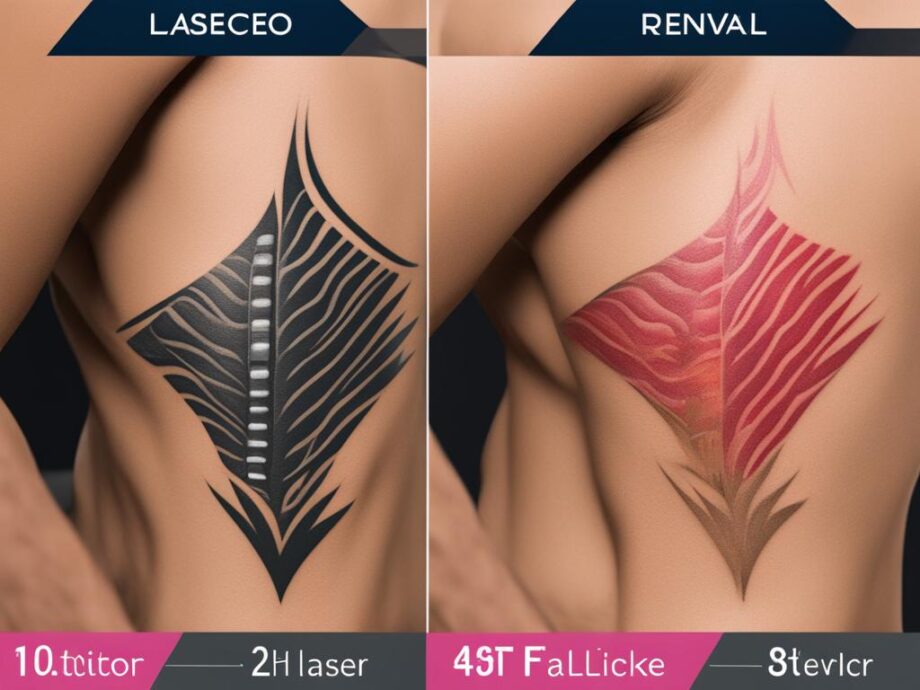Have you ever wondered about the differences between laser hair removal and tattoo removal? While both procedures involve lasers, they are quite different in their applications and benefits.
Laser hair removal is a popular cosmetic procedure that involves the use of laser technology to remove unwanted hair from the body. The benefits of this technique are many; it provides long-lasting results, is safe and painless, and can be used on almost any part of the body.
On the other hand, tattoo removal options are available for those who are looking to remove unwanted tattoos from their skin. There are several methods to choose from, including laser removal, excision, and dermabrasion. It is essential to understand the differences among the techniques before deciding on the best course of action.
Key Takeaways:
- Laser hair removal is an effective, long-lasting method for removing unwanted hair from the body.
- Tattoo removal options include laser removal, excision, and dermabrasion.
- It is important to understand the benefits and risks of each technique to make an informed decision.
- Laser hair removal is a safe and painless procedure with many benefits.
- There are several options available for those looking to remove tattoos, each with unique benefits and drawbacks.
Laser Hair Removal Process
If you’re tired of constantly shaving or waxing unwanted hair, laser hair removal might be the solution for you. Laser hair removal is a process that uses intense light beams to target hair follicles and prevent hair growth. This process is safe and effective for people of all skin types and colors.
The process involves a handheld device that emits a laser beam that passes through the skin and targets each hair follicle. The laser beam heats up the hair follicle, damaging it and preventing future hair growth. It’s essential to note that the laser beam does not harm the surrounding skin tissue.
The number of sessions required for laser hair removal varies, depending on the treatment area and hair color. Generally, multiple sessions are necessary to achieve optimal results. It’s recommended that sessions are spaced four to six weeks apart to allow the treated skin to heal. After the initial treatment plan, maintenance sessions may be required to maintain results.
Overall, laser hair removal is highly effective in permanently removing unwanted hair, with minimal discomfort and side effects.

Technology Used in Laser Hair Removal
The laser technology used in hair removal targets melanin, the pigment within the hair follicle. The laser beam is absorbed by the melanin, heats it up, and damages the follicle, preventing future hair growth. Laser hair removal devices use different wavelengths of light to target melanin in the hair follicle while minimizing any damage to the skin.
Expected Results of Laser Hair Removal
After the first session, many people notice a reduction in hair growth, with the hair becoming finer and less visible. With each subsequent session, hair growth becomes less and less until it no longer returns. In some cases, hair may grow back, but it should be finer and less visible.
Tattoo Removal Techniques
Removing tattoos can be a challenging process, but with the right techniques and resources, it can be done effectively and safely. The most common methods of tattoo removal include laser removal, excision, and dermabrasion.
Laser Removal
Laser removal is the most common technique used for tattoo removal. It involves using a high-intensity laser beam to break up the ink particles in the skin, which are then absorbed by the body’s immune system. The effectiveness of laser removal depends on several factors, such as the color and depth of the tattoo, the age of the tattoo, and the type of laser used. While generally safe, there is a risk of scarring and skin discoloration if the process is not carried out correctly.
Keyword: tattoo removal safety
Excision
Excision involves surgically removing the tattooed skin and then suturing the remaining skin together. This technique is most effective for smaller tattoos and carries a higher risk of scarring and infection. It is essential to keep the area clean and moisturized during the healing process to minimize these risks.
Dermabrasion
Dermabrasion involves removing the top layer of the skin, where the ink is situated, using a high-speed rotary tool. As the skin heals, the tattoo will fade. Like excision, this technique carries a risk of scarring and infection and requires aftercare to avoid complications.
To determine the best tattoo removal technique for you, consider assessing factors such as the age and size of the tattoo, your skin type and sensitivity, and your budget for the procedure. Consulting a qualified dermatologist or tattoo removal specialist can provide you with informed advice and guidance.
| Technique | Pros | Cons |
|---|---|---|
| Laser Removal | -Effective for most tattoo colors -Non-invasive -No scarring if done correctly |
-Risk of scarring -May require multiple sessions -Can be expensive |
| Excision | -Effective for small tattoos -Immediate results |
-Scarring and potential infection -May require suturing and longer healing time |
| Dermabrasion | -Effective for most tattoo colors -Minimal scarring -Can be less expensive than laser removal |
-May require multiple sessions -Potential for skin discoloration -Can be painful during the procedure |

Effectiveness and Safety Comparison
When considering laser hair removal and tattoo removal, it’s essential to understand the differences in their effectiveness and safety. Laser hair removal has proven to be highly effective in reducing hair growth, with many clients reporting a significant reduction in hair after just a few treatments.
On the other hand, tattoo removal success rates vary, with factors such as the size, colour, age, and location of the tattoo affecting the outcome. Laser tattoo removal is considered the safest and most effective option for most tattoos, but there is always a risk of scarring and other potential side effects.
It’s crucial to work with a skilled professional with experience in performing both treatments to ensure a safe and effective outcome. Factors that contribute to the effectiveness of both procedures include skin tone, hair type, and tattoo quality.
Laser Hair Removal Safety
When performed by a skilled professional, laser hair removal is considered safe with few side effects. Some clients may experience redness, swelling, or mild discomfort during or after the treatment, but these symptoms typically subside within a few hours.
However, clients should take necessary precautions to avoid complications. Before undergoing laser hair removal, clients should avoid sun exposure and stop using certain medications, such as antibiotics or Accutane, that can increase the risk of adverse reactions.
Tattoo Removal Safety
Tattoo removal is considered a safe procedure when performed by an experienced professional. However, certain side effects are possible, including scarring, infection, and pigmentation changes. The use of certain tattoo removal techniques, such as dermabrasion or excision, can increase the risk of scarring.
It’s important to follow the aftercare instructions provided by the professional to reduce the risk of complications. Clients should avoid sun exposure, keep the treated area clean, and avoid picking or scratching the tattoo removal site.

Cost Considerations
When considering laser hair removal or tattoo removal, cost can be a significant factor in the decision-making process. The cost of these procedures can vary based on several factors, including the treatment area, the number of sessions required, and any additional expenses.
Laser Hair Removal Cost
The cost of laser hair removal can range from $200 to $500 per session, depending on the area being treated. For example, treating a small area such as the upper lip may cost less than treating a larger area like the back or legs.
In general, it can take several sessions to achieve the desired hair reduction, with an average of six to eight treatments necessary for satisfactory results. The total cost of a complete treatment plan can range from $1,200 to $4,000.
Tattoo Removal Considerations
The cost of tattoo removal can also vary based on several factors. These include the size and color of the tattoo and the location on the body. Generally, larger tattoos will cost more to remove than smaller ones.
Most tattoo removal procedures require multiple sessions, with an average of 6 to 10 treatments necessary for complete removal. The cost per session can range from $200 to $500, with an expected total cost of $1,200 to $5,000 for the complete treatment plan.
It is important to keep in mind that the actual cost will vary depending on the patient’s unique circumstances. Additionally, some insurance plans may cover the cost of tattoo removal if it is deemed medically necessary.
Before making any decisions, it is essential to consult with a qualified professional to discuss the treatment options and discuss the cost considerations associated with each procedure.
Conclusion
As we conclude, it is evident that laser hair removal and tattoo removal are two distinct procedures. Laser hair removal offers numerous benefits, including long-lasting results and minimal discomfort. On the other hand, tattoo removal is a more complex process, with various techniques available, each with different safety and efficacy outcomes.
While both procedures have their advantages and disadvantages, it is essential to weigh the potential risks and benefits before making a decision. Ensure to work with a licensed and experienced professional to reduce the risk of complications.
Whether you opt for laser hair removal or tattoo removal, it is crucial to consider the cost implications involved. Additionally, understand that these procedures require multiple sessions to achieve the desired outcome.
In conclusion, we recommend that you conduct thorough research, seek advice from a reputable professional, and make an informed decision based on your preferences and needs.
FAQ
What is the difference between laser hair removal and tattoo removal?
Laser hair removal involves using laser technology to target and remove unwanted hair from the body. On the other hand, tattoo removal is a process of breaking down tattoo ink particles using lasers, surgical excision, or other techniques to eliminate or fade the tattoo.
What are the benefits of laser hair removal?
Laser hair removal offers several benefits, including long-term hair reduction, precise targeting of specific areas, and minimal discomfort. It is a non-invasive procedure that can provide semi-permanent results, saving individuals time and effort compared to traditional hair removal methods.
What are the options for tattoo removal?
There are various options for tattoo removal, including laser removal, surgical excision, dermabrasion, and fading creams. Laser removal is the most common and effective technique, using high-intensity laser beams to break down the tattoo ink and gradually fade the tattoo.
How does the laser hair removal process work?
Laser hair removal works by emitting a concentrated beam of light that targets the pigment (melanin) in the hair follicles. The heat from the laser damages the hair follicles, inhibiting future hair growth. Multiple treatment sessions are usually required for optimal results.
What is the effectiveness of laser hair removal?
Laser hair removal is highly effective in reducing unwanted hair. It can provide long-lasting results, with most individuals experiencing a significant reduction in hair growth after completing the recommended number of sessions. However, results may vary depending on factors such as hair color, skin type, and hormonal influences.
What are the different tattoo removal techniques?
Tattoo removal techniques include laser removal, surgical excision, dermabrasion, and fading creams. Laser removal is the most commonly used technique, where laser energy breaks down the ink particles in the skin, allowing the body to gradually eliminate them.
Is tattoo removal safe?
When performed by a trained professional, tattoo removal techniques are generally safe. However, there is a risk of potential side effects such as temporary skin discoloration, scarring, and infection. It is important to consult with a reputable practitioner and follow aftercare instructions for optimal safety.
How does the cost of laser hair removal compare to tattoo removal?
The cost of laser hair removal varies depending on factors such as the treatment area, number of sessions required, and the location of the clinic. Tattoo removal costs can also vary depending on the size and complexity of the tattoo. Generally, laser hair removal is more affordable, but individual pricing should be discussed with a qualified provider.
What should be considered when undergoing tattoo removal?
When considering tattoo removal, it is important to evaluate factors such as the size and colors of the tattoo, the location on the body, and the individual’s overall health. Consultation with a trained professional is essential to determine the most suitable technique and to discuss any potential risks or limitations.
